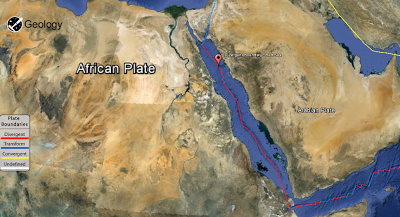
The Red Sea was formed by Arabia being split from Africa by movement of the Red Sea Rift. This split started in the Eocene and accelerated during the Oligocene. The sea is still widening, and it is considered that it will become an ocean in time (as proposed in the model of John Tuzo Wilson). In 1949, a deep water survey reported anomalously hot brines in the central portion of the Red Sea. Later work in the 1960s confirmed the presence of hot, 60 °C (140 °F), saline brines and associated metalliferous muds. The hot solutions were emanating from an active subseafloor rift. The high salinity of the waters was not hospitable to living organisms.
Sometimes during the Tertiary period the Bab el Mandeb closed and the Red Sea evaporated to an empty, hot, dry salt-floored sink. Effects causing this would have been:
- A “race” between the Red Sea widening and Perim Island erupting filling the Bab el Mandeb with lava.
- The lowering of world sea level during the Ice Ages because of much water being locked up in the ice caps.
A number of volcanic islands rise from the center of the sea. Most are dormant, but in 2007 Jabal al-Tair island, in the Bab el Mandeb strait, erupted violently. An eruption among the nearby Zubair islands followed in 2011.
Mineral resources
In terms of mineral resources the major constituents of the Red Sea sediments are as follows:
- Biogenic constituents:
- Nanofossils, foraminifera, pteropods, siliceous fossils
- Volcanogenic constituents:
- Tuffites, volcanic ash, montmorillonite, cristobalite, zeolites
- Terrigenous constituents:
- Quartz, feldspars, rock fragments, mica, heavy minerals, clay minerals
- Authigenic minerals:
- Sulfide minerals, aragonite, Mg-calcite, protodolomite, dolomite, quartz, chalcedony.
- Evaporite minerals:
- Magnesite, gypsum, anhydrite, halite, polyhalite
- Brine precipitate:
- Fe-montmorillonite, goethite, hematite, siderite, rhodochrosite, pyrite, sphalerite, anhydrite.
Note : The above story is reprinted from materials provided by Wikipedia
Plate Boundary By : USGS










